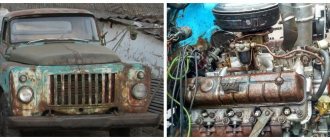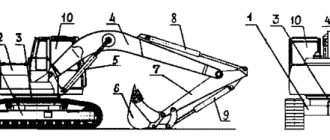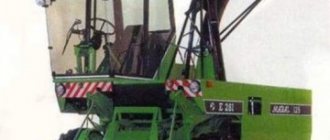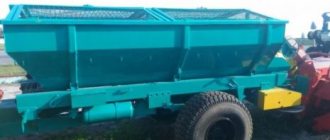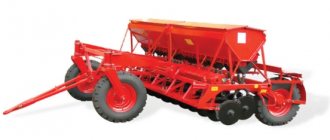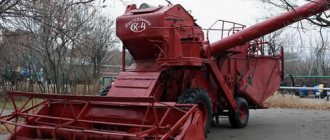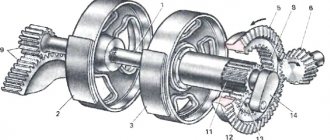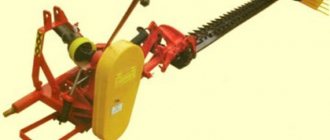Since the process of automation has firmly taken hold of the agricultural process, feed dispensers have been increasingly used in work. It is very popular among farmers, which is based in the Moscow region. It produces a wide range of products, including fertilizer application equipment, trailers and feed distributors. One of the best-selling feed dispenser models is the KTU-10.
Feed distributors
Technical specifications for feed dispensers
| Tractor universal feed dispenser KTU-10 (analogous to RKT-10, KT-10-01) without brakes. syst. with turntable and reinforced frame |
Feed dispensers are manufactured with feed dispensing on one or both sides
Purpose:
Designed for transportation and dosed distribution of crushed feed to animals indoors and on paddocks;
servicing corn and silage harvesting machines and transporting various agricultural cargoes with rear unloading; dosed supply of crushed feed to the means of loading feed storage facilities and to on-farm stationary feed distributors.
Main technical characteristics:
| Feed dispensers | KT-10-01, RKT-10, KTU-10 (one-sided, track 1600 mm) | KT-10-01, RKT-10, KTU-10 (double-sided, 1600 mm gauge) |
| Load capacity, kg, no more | 3500 | |
| Body capacity, m 3 | 9,5 | |
Transport speed, km/h, not more than:
| 10 20 | |
| Movement speed when distributing feed, km/h, no more | 2,0 | |
| Drive - tractor PTO rotation speed, min -1 | 540 | |
| Power consumption: kW/hp | 9/12,5 | |
| Wheelbase, mm | 2700 | |
| Track, mm | 1600 | |
Overall dimensions, mm:
| 6380 2300 2550 | 6570 2350 2470 |
Internal dimensions of the body, mm:
| 4000 2000 1145 | |
| Machine weight, kg | 2200 | |
| Service staff | 1 person | |
| Tire size | 240-406 (9,00-16) | |
| Service brake system | pneumatic with single-line drive | |
| Parking brake system | mechanical with manual drive | |
- Tractor universal feed dispenser KTU-10
- Technical characteristics of feed dispensers KTU-10, RKT-10, KT-6, KT-10
- Tractor feed dispenser KTU-10, KT-10-01 (analogue - RKT-10)
- Tractor feed dispenser KT-6 (analogue RMM-5)
- Tractor feed dispenser KT-10
- Spare parts for feed dispenser KTU-10
- Technical characteristics of feed dispensers (KTU-10, RKT-10, KT-10-01)
This is interesting: Husqvarna motor cultivators: technical characteristics, design features, photos and videos
What types of feed dispensers are there for cattle farms?
Feed dispenser - trailer
A large farm requires considerable physical effort and time.
But thanks to modern technology, many tasks, including feeding animals, can be done with the help of machines, making the activity easier and faster.
Increasingly, entrepreneurs began to provide their staff with feed dispensers for cattle farms, which significantly affects the quality of livestock feeding, thereby increasing the profitability of the business.
These units automate the work of feeding animals that was previously performed by human hands. Moreover, they provide rational and high-quality nutrition for livestock, since they regulate the distribution of food, the number of portions and the composition of the diet.
Advantages and features of feed dispensers
To simplify work on the farm, feed dispensers are now increasingly being used. The owner of an enterprise may consider it advisable to purchase such expensive equipment if his farm contains a large number of animals.
The unit has the following advantages and features:
- Grinds and prepares (if necessary) feed for livestock according to their needs.
- The mechanism has built-in dispensers that regulate the amount of food supplied to the animals. Serving size calculations can be determined by measuring the volume or weight of the food.
- Modern feed dispensers have a function that determines and regulates the temperature of the feed. Also, some types of units are connected to monitors, so you can monitor the preparation of food for livestock.
All these functions increase the cost-effectiveness of keeping the herd by controlling feed consumption. According to statistics, using such technologies it is possible to increase the percentage of annual cow milking by ten percent.
Types of feed dispensers
Since farming business is popular in our country, you can see very different feed dispensers on the market. It is not profitable to use them at home. However, in large industries they are necessary.
Stationary feed dispensers
Stationary unit
Stationary mechanisms for distributing feed are distinguished by the fact that they must be installed directly in the barn, without the possibility of further transportation.
The units operate using electric motors.
Stationary mechanisms can be belt, belt-slat, belt-chain or scraper type.
The main functions of such feed dispensers are to supply portions of feed into a container provided for this purpose. With the help of a transformer, food is transported and distributed throughout all pens.
Examples of the most common feed dispensers in our country:
- KRS mechanism – 15.
- TVK dispenser – 80B.
- Single-sided tape KLO – 75.
- Tape double-sided CLC – 75.
- Dispenser used on dairy farms, RK – 50.
Mobile feed dispensers
Mobile feed dispenser
Mobile distributors distribute and serve dry and green fodder to livestock.
Semi-liquid nutrition is provided using special mixers (often purchased from pig farms).
The mobility of the mechanism is explained by the fact that it distributes feed from the bunker, and distributes it to the feeders of all pens of the farm using dispensers, which are equipped with the function of independent movement.
The mobility of mixers working with liquid and semi-liquid mixtures is relative. This is explained by the fact that units of this type move along special tracks pre-installed on the floor surface. They can carry out their mission exclusively in one building.
An important advantage of this type of dispenser is that they mix liquid or semi-liquid feed before serving it to livestock. Thanks to this function, all animals receive food of uniform consistency.
Among the mobile feed dispensers that have earned a good reputation in our country are:
- Unit RS – 5A.
- Mechanism KS – 1.5.
- Dispenser KSP – 0.8.
- Universal action unit KTU – 10A.
- Small RMM – 5.0.
- Mixer RSP – 10.
The size and volume of the feed hopper can be selected according to the number of livestock kept on the farm. The farmer can also choose the type of unit drive that suits his case, its operating speed and level of productivity.
About the owner feed dispenser - presented in detail in the video:
Scope of application
The abbreviation of this special tool stands for “universal tractor feed dispenser.” The unit is most often produced in the Russian Federation, Ukraine and Belarus by the largest local manufacturers of agricultural equipment. The KTU has the form of a trailer, which must work in conjunction with tractor equipment belonging to the 1.4TC class. A typical representative of such a tractor is the Belarus model MTZ-80/82.
The main purpose of the feed dispenser is processing, transportation, as well as dosed distribution of various types of feed. Most often, the unit is used for silage made from corn and sunflowers. Often other plants, cereals and legumes are used to prepare feed.
The unit is designed for distributing feed
The unit is widely used in conjunction with forage harvesters, when the harvested feed enters the trailer. Then, the feed mass is unloaded into special storage facilities, stationary modifications of feed dispensers, or directly into feeders near the animals’ placements. KTU is also suitable for simple transportation of already prepared feed, as well as straw.
Scope of economic application
The KTU-10 feed dispenser is designed for processing, transportation and dosed distribution of feed masses of various origins. First of all, we mean corn and sunflower silage. As well as other crushed leafy foods, cereals or legumes, chopped root vegetables, and all kinds of complete feed mixtures.
Trailers of this model can be used directly for harvesting corn or sunflower for silage, when the feed mass comes directly from the forage harvester to the trailer. And from the trailer it is subsequently unloaded into stationary storage facilities on livestock farms or into special stationary distributors located in close proximity to the places where the animals are placed. Or - directly into animal feeders. Most often, KTU-10 feed dispensers simply run between silos and farms, ensuring timely delivery of feed.
Cows eat silage delivered by a feed dispenser.
During distribution, “KTU-10” pours ready-made feed, in the form of a continuous, controlled flow, into feeders with side heights of no more than 750 mm, arranged as in open feeding areas, walking and feeding bases and summer camps; and in closed premises of livestock farms and complexes. The width of the passage on a farm or complex requires a trailer of 2100 mm. The KTU-10 distributor is also used for transporting and unloading bedding material for animals (chopped straw) to the right places.
Design Features
As mentioned earlier, the KTU 10a feed dispenser, like its standard modification, is a tractor trailer made of metal and placed on a pneumatic wheelbase. The rear side of the unit can be opened as needed, allowing feed to be unloaded automatically.
The internal equipment of the metal body assumes that its bottom is trimmed with wooden elements, and special conveyors are located along its entire length. The conveyor-beater mechanism of the unit, which is designed for uniform supply of feed placed in the body during unloading, deserves special mention. It includes the following elements:
- conveyor of anchor-longitudinal or roller-bushing type;
- conveyor located across;
- beater block.
Be sure to read: Round baler PRF-110
The first element is a special transmission made of chains, drive shaft and axles. The beater unit consists of two fixed drum-type beaters. The transverse conveyor appears to be nothing more than a canvas consisting of two main parts, stretched over shafts.
Among other things, the power take-off shaft, which is responsible for driving the transfer mechanisms, deserves mention, since it seems to be one of the most important design elements. Such a shaft consists of:
- main drive;
- cardan shaft;
- transverse drive;
- gearbox;
- longitudinal drive.
The front axle is used to make turns when driving; it is a beam with rotating elements. The rear one, on the contrary, is static and is used to move or brake the device.
Feed dispenser diagram
Specifications
Technical characteristics of the KTU-10 feed dispenser:
| Characteristics | Indicators | Unit measurements |
| Length | m | 6,67 |
| Width | m | 2,3 |
| Height | m | 2,5 |
| Wheelbase | m | 2,75 |
| Weight | T | 2,1 |
| Clearance | cm | 30 |
| Speed | km/h | 30 |
| Tires | mm | 12-16 |
| Load capacity | T | 4 |
| Performance | m3/h | 72-480 |
| Power | kW | 7,5 |
This is interesting: Honda cultivators: device, technical characteristics, photos and videos
Feed dispenser KTU-10 from the popular
Since the process of automation has firmly taken hold of the agricultural process, feed dispensers have been increasingly used in work. It is very popular among farmers, which is based in the Moscow region. It produces a wide range of products, including fertilizer application equipment, trailers and feed distributors. One of the best-selling feed dispenser models is the KTU-10.
UNIVERSAL TRACTOR FEED DISPENSER KTU-10A
LABORATORY WORK No. 1 MOBILE FEED DISPENSERS
study the purpose, device, workflow and adjustments
mobile feed dispensers for cattle farms
To distribute feed to cattle, mobile feed dispensers KTU-10A, RMM-F-6, RSP-10, ARS-10, ISRK-12 “Host” are used.
Technical characteristics of mobile feed dispensers are presented in Table 1.
Technical characteristics of mobile feed dispensers
UNIVERSAL TRACTOR FEED DISPENSER KTU-10A
Feed dispenser KTU-10A
designed to perform the following work: receiving, transporting and dosed distribution of crushed feed and ready-made feed mixtures to animals, transporting various products with unloading back; dosed supply of feed to on-farm stationary feed dispensers and feed storage facilities.
The feed dispenser is used in typical livestock buildings, the feed passage must be at least 2200 mm wide and the height of the feeders 750 mm, in walking areas and summer camps, as well as when preparing feed as a vehicle.
It is aggregated with tractors of the MTZ type, the working parts of the feed dispenser are driven by the power take-off shaft of the tractor.
The feed distributor KTU-10A (Fig. 1) is a two-axle tractor trailer on springs and pneumatic wheels 4. It consists of a body 2 with a capacity of 10 m 3 with extension sides, At the bottom of the bunker there are two longitudinal chain-slat conveyors 5 designed to move the feed layer from the rear to the front wall of the body. The drive shaft of the conveyors is located in the front part of the body, driven into rotation from the lower beater shaft through a crank mechanism. A block of beaters 1, which acts as dispensers, and a transverse conveyor 6, which dispenses feed into the feeder, are mounted in the front part of the body.
1 – beater block; 2 – bottom (base of the body); 3 – side board;
4 – chassis; 5, 6 – longitudinal and transverse conveyors;
7 – distributor drive with cardan; 8 – spoke
Figure 1 – Universal tractor feed dispenser KTU-10A
The feed dispenser has a chassis 4, which consists of a frame, front and rear axles with springs and four pneumatic wheels, and a towbar. The rear wheels are equipped with shoe brakes with a hydraulic drive, controlled from the tractor driver's cab.
The towing device 8 is connected at one end to a rotary joint, and at the other there is a towing eyelet.
Transverse conveyor 6 consists of two belt conveyors. When distributing feed, one cloth assembled from two small ones is installed on one side; when distributing food on two sides, two small cloths are installed. In this case, the tension sprocket of the conveyor drive chain is removed and installed in a different position, ensuring that both conveyors are driven in opposite directions. The ratchet mechanism serves to regulate the rate of feed dispensing into the feeders and consists (Fig. 2) of a connecting rod 1, a ratchet wheel 4, an eccentric disk 3, movable 2 and fixed 5 pawls, springs for holding the pawls in a given position and a sector 6. The ratchet mechanism provides movement of the longitudinal conveyor forward when distributing feed, and backward when the feed dispenser is operating to transport goods.
Work process. The feed dispenser must be loaded with feed evenly; the space above the transverse conveyor must not be filled. The tractor driver transports the feed dispenser to the feeders, turns on the PTO, when moving the distributor along the feeders, the longitudinal chain-slat conveyor 3 moves the feed mass located in the hopper 1 (Fig. 3) to the beaters 2, which loosen and separate a certain layer of feed, then transfer it to the transverse 4 conveyors feeding feed from the body to feeding troughs
Feed dispenser KTU-10
The KTU-10 model is designed for processing and dosing feed mass, for harvesting agricultural crops in conjunction with harvesting machines, for unloading crushed feed into stationary dispensers, which are located in close proximity to animals, as well as for unloading mass into storage facilities. The KTU-10 feed dispenser has the following features:
- The design of the equipment is a towing device based on rubber wheels. The body is made of especially durable metal, and conveyors are mounted along the bottom.
- The chassis is as simple as possible, and it is equipped with hydraulic brakes. The entire braking system is controlled by the driver from the tractor with which the feed dispenser is mounted.
Uniform distribution of feed is ensured by a unique distribution mechanism, which consists of conveyors, belts, and beaters.
Overview of modifications
The feed dispenser of this model is available in several modifications, which differ slightly from each other. The standard model fully complies with the characteristics and design described earlier.
There are several variations of the popular model:
- KTU-10A is an improved modification, characterized by the presence of a turning circle, as well as a reinforced frame. In all other technical characteristics, this unit is completely identical to its standard counterpart;
- KT-6. A characteristic feature is an enlarged body compartment with smaller dimensions and carrying capacity. This makes the device more maneuverable, but not suitable for intensive use under heavy loads;
- KT-10-01. It is distinguished by the absence of brake elements, but some modifications provide for their presence.
Be sure to read: Fuel tanker volume
Thanks to such a variety of modifications, each buyer can choose the optimal solution for feeding feed, taking into account the individual requirements and characteristics of the farm.
Owner reviews
Despite the fact that the design of the model has not been updated for a long time, KTU still remains one of the most popular models of units of this type. It is widely used in large and small farms, and its owners characterize the KTU as a high-quality and reliable device.
Be sure to read: Small-sized and stationary drilling rigs
If you study the reviews of KTU holders in more detail, you can highlight the following advantages:
- affordable price;
- simple and reliable design;
- good performance and ease of use.
The model has practically no disadvantages, which makes it the best option for distributing feed to animals. At the same time, some owners note the likelihood of minor breakdowns, which can be easily fixed on their own, without the involvement of qualified personnel.
Description and characteristics of the best feed dispensers
When deciding which feed dispenser is suitable for your farm, look carefully at the characteristics of this equipment. The parameters of the dispensing mechanisms can be general (for example, operating speed, volume of the feed hopper, number of heads served) and individual, relating to a specific model.
For mobile equipment, the transported mass of feed, the speed and area of its movement during operation, and dimensions are important. When purchasing a stationary model, look at its power and the speed at which the belt moves.
Stationary
Stationary equipment is most often installed on farms with a large number of livestock. This helps make feeding the animals easier and easier. However, on small farms such dispensers can also be seen (for example, if mobile devices are not suitable due to the size of the feeders or the premises itself).
The most famous models:
- TVK-80B. This is a belt model that is suitable for all dry and solid food. The device contains a tape in the shape of a closed ring, about 0.5 m wide. Power comes from an electric motor, which makes the tape move. The feed from the hopper is distributed in equal portions along the feeding container, and then the device is turned off. Such a distributor allows you to fully automate the process of feeding livestock.
- RK-50A. A dispenser with a conveyor belt is located above the feeder and distributes small feed. The structure of the mechanism is as follows: inclined and transverse conveyor, 1 or 2 dispenser-conveyor, control unit. Moreover, each conveyor has its own electric drive. The feed goes this way: an inclined conveyor, then a transverse conveyor, directing the food to a conveyor-distributor, a feeder.
- KRS-15. Type of scraper feed dispenser for animals. Most often used for succulent, dry food and various mixtures. A conveyor, consisting of two distribution channels, runs along the bottom of the feeder. The device starts working using an electric motor. The feed is fed into the fence and then distributed by scrapers. As soon as the scraper completes a full rotation, the drive is switched off.
Comparative table of technical characteristics of stationary feed dispensers:
| Model | Feeding area length | Number of heads served | Engine power | Performance |
| TVK-80B | 74 m | 62 | 5.5 kW | 38 t/h |
| RK-50A | 75 m | 100 or 200 | 9 kW | 3-30 t/h |
| KRS-15 | 40 m | 180 | 5.5 kW | 15 t/h |
Mobile
Mobile distributors can be used on all farms where the dimensions of the premises allow it. The advantage of such dispensers is that they not only distribute food to animals, but also deliver food from the storage or preparation site. And mixer dispensers also mix the feed before giving it away for consumption.
Device
The main elements of the feed dispenser are:
- Body. Its rear sides are hinged, and the floor is finished with wooden boards.
- The chassis, consisting of a frame, axles, springs, as well as a towing mechanism, secured with hinges and having a towing loop.
- The longitudinal conveyor is a pair of parallel chains that move along the bottom of the body. It is driven by a drive shaft and a beater shaft.
- Beaters are the basis of the dispensing device.
- The braking system is based on the rear wheels. The blocks are driven by the tractor driver from the cab.
- Electrical equipment.
Diagram of the feed dispenser KTU-10
1 - bottom, 2 - rear board, 3 - side board, 4 - extension board, 5, 18 - enclosing panels, 6 - sidewall, 7 - beater block, 8 - reflector shield, 9 - front side, 10 - unloading conveyor , 11 – distributor drive, 12 – brake device, 13 – telescopic shaft, 14 – hydraulic mechanism for lifting an additional conveyor, 15 – chassis, 16 – additional conveyor, 17 – rear light and turn signal.
The process of preparing mixed feed mixtures
Often, pet food is not purchased, but prepared independently. In this case, you need to know the rules of cooking and follow some requirements. For example, feed for cattle should be:
- homogeneous;
- moist within 65-80%;
- without the formation of mold and foreign impurities;
- maintaining a balance of biological additives, vitamins, stimulants.
Having your own workshop for preparing feed makes it possible to reduce the cost of food for animals. This occurs through the use of its resources (various waste, remnants of plant materials - grass or branches).
Based on the needs of the cattle farm, you can safely choose the appropriate feed dispenser. Take into account the number of animals and the size of the farm itself. Based on these indicators, purchase a dispenser that is suitable in speed, size and capacity.
0
Reviews from KTU-10 owners
Despite the fact that this model of agricultural machinery cannot exactly be called innovative, it has not lost its relevance in the twenty-first century. At large and medium-sized livestock complexes for breeding cattle, this functional trailer is a necessary and valuable assistant in peasant farming.
The undeniable advantages that KTU-10 owners talk about in their reviews are extreme simplicity of design and ease of use. No additional personnel are required; one operator on a tractor is enough to operate the feed dispenser.
The new “KTU-10” has “arrived” to its owner.
No significant shortcomings were identified during the operation of the feed trailer. In operation it demonstrates high reliability and durability. Any breakdowns do not lead to long downtime and can be repaired without the involvement of special technical personnel.
Modifications
The feed dispenser of this model has several modifications.
KT-6 differs in body volume, its capacity is 6 m3, there are models with one-way and two-way distribution.
Technical characteristics of the KT-6 model:
| Characteristics | Unit measurements | Indicators |
| Length | m | 5,76 |
| Width | m | 2,1 |
| Height | m | 2,18 |
| Wheelbase | m | 1,86 |
| Weight | T | 1,45 |
| Clearance | cm | 28 |
| Speed | km/h | 35 |
| Load capacity | T | 2 |
| Body capacity | m3 | 6 |
| Power | kW | 4,5 |
Photo of feed dispenser KT-6
KT-10-01. This model is characterized by the absence of a braking system; there are variations on the brake circles and on the rods.
Parameters of feed dispenser KT-10-01:
| Characteristics | Unit measurements | Indicators |
| Length | m | 6,67 |
| Width | m | 2,3 |
| Height | m | 2,5 |
| Wheelbase | m | 1,6 |
| Weight | T | 2,1 |
| Clearance | cm | 30 |
| Speed | km/h | 25 |
| Load capacity | T | 4 |
| Body capacity | m3 | 10 |
Photo of feed dispenser KT-10-01
KTU-10A has a turntable and a reinforced frame, and has the following characteristics:
| Characteristics | Unit measurements | Indicators |
| Length | m | 6,67 |
| Width | m | 2,3 |
| Height | m | 2,5 |
| Wheelbase | m | 2,75 |
| Weight | T | 2,1 |
| Clearance | cm | 30 |
| Speed | km/h | 30 |
| Tire | mm | 12-16 |
| Load capacity | T | 4 |
| Performance | m3/h | 72/480 |
| Power | kW | 7,5 |
Video review of the KTU-10 feed dispenser:
Spare parts for feed dispenser KTU-10
feed dispenser KTU-10
Prices are adjusted when ordering
| №/№ p/p | Products offered | Designation |
| 1 | Conveyor for feed mill KORK-15 | TS-40.OM |
| 2 | Conveyor for feed mill KORK-15 | TS-40.OS |
| 3 | Longitudinal conveyor with anchor chain | RMM.00.1280-03 |
| 4 | Conveyor with bushing and roller chain | RMM.00.230 |
| 5 | Cross rubber conveyor | RMM.00.040-05 |
| 6 | Short transverse rubber conveyor | KTU-9-11/2-sided |
| 7 | Long transverse rubber conveyor | KTU-9-11-01 |
| 8 | Short transverse rubber conveyor | KT-6. 23.000SAT |
| 9 | Long transverse rubber conveyor | KT-6. 03.000SAT |
| 10 | Longitudinal conveyor with anchor chain | KTU.50.0220-10 |
| 11 | Longitudinal conveyor with roller chain | PTV-2.4M |
| 12 | Longitudinal conveyor with anchor chain | KT-10.04.060SB |
| 13 | Longitudinal conveyor with roller chain | KT-10.04.100SB |
| 14 | Longitudinal conveyor with anchor chain | KT-6.04.150SB |
| 15 | Longitudinal conveyor with roller chain | KT-6.04.160SB |
| 16 | Conveyor to ROU-6 | ROM.00.1270 |
| 17 | Sprocket driven/leading to ROU-6 | PIN-01.118A/PIN-01.117B |
| 18 | Shaft leading to the ROU-6 conveyor | |
| 19 | Turning circle | RKT-10(2PTS-4) |
| 20 | Distributing table for KTU-10 is one-sided | KTU.55.1091 |
| 21 | Distributing table for KTU-10 double-sided | KTU.55.1092 |
| 22 | Drive shaft of the transverse conveyor | KTU.00.6002-1 |
| 23 | Transverse conveyor drive shaft driven | KTU.00.6002-2 |
| 24 | Cross drive drive shaft assembly | KTU.50.4050-1 |
| 25 | Transverse drive driven shaft assembly | KTU.50.4050-2 |
| 26 | Shaft No. 6 assembled | KTU.50.5850 |
| 27 | Shaft No. 6 | KTU.00.6025 |
| 28 | Drive unit | KTU.50.3770 |
| 29 | Beater drive shaft assembly | KTU.50.1470 |
| 30 | Beater drive shaft | KTU.50.6046 |
| 31 | KT-10 bushing-roller shaft | KT-10.04.170 |
| 32 | KT-10 anchor shaft | KT-10.04.110 |
| 33 | KT-6 bush-roller shaft | KT-6.04.170 |
| 34 | KT-6 anchor shaft | KT-6.04.110 |
| 35 | Shaft (anchor) | KTU-50.0900 |
| 36 | Shaft (bush-roller) | KTU-50.0900 |
| 37 | Beater drive shaft | KT.6.05.603 |
| 38 | Beater drive shaft assembly | KT.6.05.010 |
| 39 | Beater drive shaft | KT.10.05.611 |
| 40 | Beater drive shaft assembly | KT-10 05.010 |
| 41 | Drive shaft of longitudinal conveyors | KTU.50.6001 |
| 42 | Cardan shaft | KTU.50.0560 160 n.m. |
| 43 | Cardan shaft | KT-6, KT-10 160 n.m. |
| 44 | Drive shaft of longitudinal conveyors | KT.10.04.601 |
| 45 | Drive shaft of longitudinal conveyors | KT.6.04.603 |
| 46 | Shaft | KTU.50.6002 |
| 47 | Crank drive shaft assembly | KTU.50.6350 |
| 48 | Crank drive shaft | KT.10.05.034 |
| 49 | Eccentric drive shaft assembly | KT 10.05.022 |
| 50 | Crank drive shaft | KT.6.05.031 |
| 51 | Rear axle of longitudinal conveyor | KTU.00.678.02 |
| 52 | Rear longitudinal conveyor shaft | KT.10.04.602 |
| 53 | Rear longitudinal conveyor shaft | KT.6.04.604 |
| 54 | Anchor chain | 1A 9x27 |
| 55 | Bush-roller chain | TRD-38-3000-2-6 |
| 56 | Bush-roller chain | PR-19.05-31.8 |
| 57 | Bush-roller chain | PR-25.4-60 |
| 58 | Connecting chain link (lock) | 19,05; 25,4; 38,1 |
| 59 | Sprocket block (per beater block) | 50180 |
| 60 | Drive sprocket (anchor chain) | KTU.00.124 |
| 61 | Drive sprocket (anchor chain) KT10; KT-6 | KTF.12.05.301 |
| 62 | Driven sprocket (anchor chain) | KTU.00.125 |
| 63 | Driven sprocket (anchor chain) KT10; KT-6 | KTF.12.05.302 |
| 64 | Drive sprocket (bush-roller chain) | PTV-202-2-4 |
| 65 | Drive sprocket (bush-roller chain) | KT.10.04.140 |
| 66 | Drive sprocket (bush-roller chain) | KT.6.04.190 |
| 67 | Driven sprocket (bush-roller chain) | PTV 1006 |
| 68 | Driven sprocket (bush-roller chain) | KT.10.04.160 |
| 69 | Driven sprocket (bush-roller chain) | KT.6.04.200 |
| 70 | Beater drive sprocket | KTU.00.6042 |
| 71 | Beater drive sprocket | KT.10.05.071 |
| 72 | Beater drive sprocket | KT.6.05.060(KTU00.0870 |
| 73 | Beater sprocket | KTU.50.0190 |
| 74 | Beater block sprocket | KT.6.06.090 |
| 75 | Beater block sprocket | KT.6.06.080 |
| 76 | Beater block sprocket | KT.6.06.070 |
| 77 | Cross table drive sprocket | 9.15 |
| 78 | Reducer drive sprocket | KTU.00.664 |
| 79 | Table drive chain tension sprocket | KT.6.05.040(960/01) |
| 80 | Tension sprocket assembly for beater drive | KTU-00.1030-01A |
| 81 | Crank drive shaft sprocket | KT.6.05.070(KTU.00.450) |
| 82 | Crank | KTU.00.1490 |
| 83 | Ratchet wheel | KTU.50.6005 |
| 84 | Scraper | PTV, KTU |
| 85 | Lid | 1073,1071,N.026164 |
| 86 | Lid | 113 |
| 87 | Bearing shell | KTU.00.102 |
| 88 | Bearing shell | N.26059 |
| 89 | Bearing shell | KTU.55.4495 |
| 90 | Bearing shell | 1072 |
| 91 | Beater side | KTU.50.1680 |
| 92 | Beater side | KTU.50.5140 |
| 93 | Sidewall of the transverse conveyor | KTU.50.2050A/KTU.50.2040A |
| 94 | Table 2-sided/1-sided | KTU.50.4040A/KTU.50.4050 |
| 95 | Visor | KTU.50.4423 |
| 96 | Tensioner | KTU.55.5500 |
| 97 | Anchor chain lock | 1A 9x27 |
| 98 | Wheel disk | 331013 |
| 99 | Spring | KTU.00.6008 |
| 100 | Spring | PTV-6228 |
| 101 | Beater KT-6 top/bottom. | KT-6.06.030/KT-6.06.040 |
| 102 | Beater KT-10-01 (KTU) | KTU.50.1660 |
| 103 | Beater KT-10 lower | KT-10.06.031-01 |
| 104 | Beater KT-10 upper | KT-10.06.031 |
| 105 | Beater block | KTU.50.1670 |
| 106 | Lever arm | KTU.50.4054/50.3780 |
| 107 | Spring | 887A-2902012 |
| 108 | 1st leaf spring | 2PTS-4 |
| 109 | Gearbox | N.091.20.000A-113 |
| 110 | Hub with bearing | 3103010 |
| 111 | Dog | PTV-6006 |
| 112 | Flange | PTV 6025 |
| 113 | connecting rod | KTU.50.2980 |
| 114 | Ladder | 887A-2912408 |
| 115 | Agricultural tires | 240x406(9x16) |
| 116 | Car camera | 240x406(9x16) |
| 117 | Bearing | KTU.00.1310-01 |
| 118 | Bearing | KTU.50.0330 |
| 119 | Bearing | KTU.50.5330 |
| 120 | Bearing | 180206 |
| 121 | Bearing | 11207 |
| 122 | Bearing | 1508 |
| 123 | Bearing | 7609 |
| 124 | Bearing | 7611 |
| 125 | Bearing | 308 |
| 126 | Half coupling for shaft No. 6 | KTU.6007-A |
| 127 | Half coupling for shaft No. 6 | KTU.00.1930 |
| 128 | Half-coupling assembly for shaft No. 6 | KTU.00.1940 |
| 129 | Washer | KTU.00.042 |
| 130 | Ice rink | KTU.00.22A |
Operating rules
After purchasing a new KTU, you should pay due attention to its proper running-in. This will allow you to be confident in the long service life of the dispenser, as well as to ensure that its actual characteristics correspond to the manufacturer’s statements. The rules for running in are extremely simple:
- break-in time - 15-30 minutes;
- the procedure provides that the engine first operates at reduced speeds, followed by a smooth increase to normal values;
- the feed mass supplied to the unit must be supplied evenly;
- When distributing, you should switch the gearbox to speed 1-2, and also use the specialized operating mode.
It should be borne in mind that such a unit does not tolerate storage and operation at low temperatures relatively well. In this regard, it is recommended to place it in heated rooms, and also to refuse or minimize its use in the cold season.
However, this is only relevant for feed mass of the wet type. If you plan to use dry food, then the operating temperature range will expand from -40 to +50, which will allow you to use the mechanism without restrictions. There are restrictions regarding what feed can be used.
Hay particles should be no more than 4 cm in length, and other types of plant feed - no more than 6 cm. Particles of this size should be more than 80% of the total processed feed mass. The feed passage for distribution must be at least 2.2 m, which is due to the dimensions of the equipment.
The feed dispenser is extremely easy to use
Operational Features
Before use, the feed dispenser should be run in for half an hour. You should start with low speed, and then switch to normal. The KTU-10 model is aggregated with the Belarus tractor.
The equipment is loaded with feed mass evenly. To distribute feed, you must turn on a special operating mode, and the gear lever must be moved to 1st or 2nd gear.
The vehicle body is designed so that feed distribution is possible on both sides of the body. For one-sided distribution, one transport sheet is required, and for two-sided distribution, two.
To use the feed dispenser as a transport device, the ratchet mechanism must be activated, and for self-unloading, a special arrangement of pawls and discs is used. This agricultural machinery allows you to regulate the supplied feed mass by changing the speed of the conveyor.
At sub-zero temperatures, the feed dispenser must be kept in a warm room to avoid the formation of ice on conveyors and other moving mechanisms.
Classifications of feed dispensers
There are various models of feed dispensers, adapted to the specific maintenance and needs of animals. The main classification involves mechanisms that differ in the method of movement, distribution option and ability to transport a certain weight of feed.
By way of movement
The method of movement is the main characteristic by which feed distributors differ. Depending on whether the device can be moved, farm equipment is selected.
Distributors can be:
- Stationary . Such equipment is installed above or near feeders and cannot be moved. The peculiarity of such mechanisms is that they supply feed in containers directly from the bunkers, where the mixture is prepared for consumption.
- Mobile . They look like carts with a feed container. Such devices can take food for livestock at any designated place and transport it to the feeders, evenly distributing it. This equipment is intended mainly for dry and green food. Movement occurs with the help of equipment - a car or a tractor.
- Partially mobile (dispensers-mixers). This is a type of mechanism that transports feed of liquid or semi-liquid consistency. Their movement is carried out along special tracks located on the floor of the building, so the movement of the devices is limited. But their advantage is that they can mix the feed before feeding it into the feeder, making the food homogeneous.
stationary dispenser
mobile dispenser
partially mobile (dispenser-mixer)
The advantage of stationary devices is their simple structure and ease of installation. They are used mainly on small farms. On the side of mobile mechanisms is the ability to deliver feed to any point and ease of use.
Stationary devices for cattle can be:
- tape - they have a special roller tape in their device;
- platform - there is a conveyor that dispenses feed in doses;
- scraper - chain-scraper conveyors move along a concrete chute;
- cable-washer – feed is delivered using a cable with fixed washers moving inside the pipe.
The movement of mobile distributors occurs on tractor units or a car frame, but there are also completely autonomous mechanisms powered by electricity. As for the mixer dispensers, they operate under the control of operators using levers and a remote control and are also “powered” by electricity.
By distribution type
The type of distribution of feed dispensing mechanisms can also be different. There are devices that supply food and mixtures only on one side and those that can do this on both sides of the container where the animals eat.
By load capacity
The differences in carrying capacity indicate how much weight the distributor can carry. This classification is typical specifically for mobile devices. This indicator depends on the number of axles of tractors and the carrying capacity of the chassis of the vehicles on which the distributor is installed.
The average load capacity of feed dispensing devices can be as follows:
- for vehicles with one axle – 1.1-3.0 t;
- for mechanisms with two axes - 3.5-4.0 tons.

